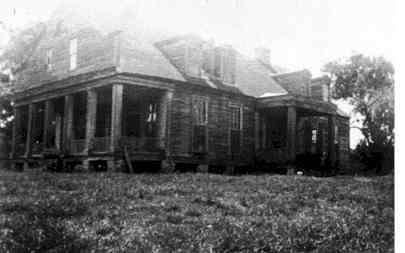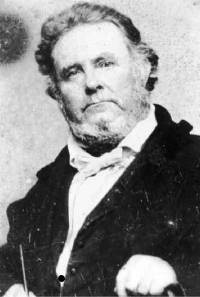|
Waverly:
Grant's Headquarters
by During the Battle of Raymond, General U.S. Grant selected Waverly, as his headquarters. Located on what is now the Raymond-Clinton Road, the home provided the perfect location for the Yankee general and his men. The history of Waverly goes back to 1829 when John B. Peyton and his wife, Mary Fairchild Lewis, moved to the area of Raymond, a newly established town designed to become the county seat. "John B. and Mary moved into Hinds County near Edwards Station in 1825. His brother-in-law told him he should buy some land near present-day Raymond because it was such a pretty location. They were both surveying the land ceded by the Treaty of Doak's Stand in 1820. John Peyton received his first land patent in 1828 for land in Section 17 - it was signed by Andrew Jackson. In 1829, he moved his family into Raymond and began to build Waverly, dated 1831-1834."
Waverly was built 1831-1834 on a parcel of land approximately a quarter of a mile from the town's courthouse. "It was built to be a replica of his grandfather's house in Fauquier County, Virginia. The original front faced east and the present front was the southern gallery with a bench the width of the porch at each end. There was a large four-foot door from this gallery to the big parlor and a door to the hall between the two parlors. The little parlor had a fireplace but the big parlor had no heat. The house was forty by seventy feet with an addition of a porch leading to the kitchen. This porch was between two cisterns and was reached from the dining room door. There was a fireplace in the dining room - it shared the chimney of the fireplace in the master bedroom. John B's library had two sets of double doors and extended from the fireplace mantel to the back wall. The dining room fireplace had a crane in it to hold pots and kettles. Waverly had four bedrooms upstairs. The space between the bedrooms and around the stairs was used as an upstairs sitting room. There was much eave space also, although only two of the spaces were floored and had doors. The stairway went up from the brick floor space - this was enclosed and had large double doors that opened inward. In bad weather the carriage was backed in so that the ladies would not be exposed to rain or cold." John B. Peyton was considered to be a 'founding father' of Raymond. He was well known in Hinds County for having served two terms in the House of Representatives. He was also a successful planter, surveyor and farmer. One of his most successful projects was the Bolton Railroad. "He was the ringleader for the Bolton Railroad built to connect with the Alabama and Vicksburg." This pioneering railroad ran from Raymond to Bolton where passengers could intercept the major line at Bolton Station. 
On May 12, 1863, when the war came home to Raymond, General Grant and his men occupied Waverly and camped on the grounds. Two days after the Battle of Raymond, Charles Vogel, a Union soldier, made an entry in his diary stating, "May 15, 1863…..Come to Raymond, splendid little town, the courthouse and churches used as hospitals for wounded on both sides. Camped a little (1/4 mile) outside of town, seen J.W. Peyton's Drug Store demolished. A good many inhabitants left." Recalling the war years, the Peyton family stated, "Some Union troops, including the above, camped where our garden now grows, alongside the Raymond-Bolton Railroad. We have Yankee minie balls found in the garden area." The camp site described by Charles F. Vogel, Co. E, 29th Regiment, Missouri Infantry, U.S.A., was Waverly. The Peyton family remained in the home during Grant's brief occupation. The history of Waverly during the Battle of Raymond was preserved by family members who recorded General Grant's stay, "Of interest is the fact that General Grant arrived on Peyton property on May 13, 1863 and left on May 14th. He slept in his tent in Waverly's front yard, but used the gallery and the big parlor for conferences with his officers. He used the east end of the porch in the afternoon and the west end of the porch in the morning. Aunt Anne later told of John B. and General Grant having an amiable conversation about affairs of the day. Grant was smoking his long black cigar and John B. was smoking his long clay pipe. Aunt Anne asked for a meeting with General Grant and the meeting was arranged. She told him, 'You see these children? They are hungry and you have taken every morsel of food that I had to feed them. What are you going to do about it?' Grant replied that he was going to give her some food back, and he did. He also wrote out orders to allow Mr. Peyton's servant to enter the Army corral to remove his cows and work oxen. He also wrote that no troops coming this way in the future were to bother anything on this place." Long after General Grant and his men left Raymond, historic Waverly, continued to be the home of the Peyton family. It has been in the family and passed down from one generation to the next for 168 years. Waverly is now remembered not only as being the home of one of Raymond's founding fathers but also for the role it played during Civil War years. *All quotes from ‘Personal Notes Regarding Waverly and the Peyton Family’ by Opal Peyton © 1998-2005, all rights reserved |
 Waverly's
history directly corresponds with the earliest years of the history of
Raymond. Raymond was laid out as early as 1828 and received its charter
on January 14, 1829. "The land for the town was a pine forest
with many other trees as well. The land was cleared, the town laid out
in squares and divided into lots. The courthouse was erected in 1830 and
the land records were moved from Clinton (temporary county seat) to
Raymond."
Waverly's
history directly corresponds with the earliest years of the history of
Raymond. Raymond was laid out as early as 1828 and received its charter
on January 14, 1829. "The land for the town was a pine forest
with many other trees as well. The land was cleared, the town laid out
in squares and divided into lots. The courthouse was erected in 1830 and
the land records were moved from Clinton (temporary county seat) to
Raymond."